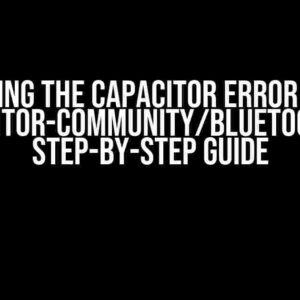Are you tired of dealing with pesky thread issues that only trigger once? Do you struggle to detect language or caps lock changes in your application? Look no further! In this article, we’ll dive into the world of threads and explore the mysteries of language and caps lock detection. Buckle up, folks, as we embark on a journey to trigger bliss!
Understanding the Problem
Before we dive into the solution, let’s first understand the problem at hand. You’ve probably encountered a situation where you need to detect language or caps lock changes in a thread. This could be in a chat application, a text editor, or any other scenario where user input is crucial. The issue arises when the detection trigger only works the first time, leaving you wondering why it doesn’t work subsequently.
The Culprits: Thread and Synchronization
The primary culprits behind this issue are thread management and synchronization. When multiple threads are involved, ensuring proper synchronization is crucial to avoid data inconsistencies and unexpected behavior. In this case, the thread responsible for detecting language or caps lock changes might be getting blocked or terminated, causing the trigger to only work once.
Solution: Implementing a Custom Thread Detector
To overcome this hurdle, we’ll create a custom thread detector that listens for language or caps lock changes and triggers accordingly. This detector will be designed to run indefinitely, ensuring that changes are detected and handled correctly.
Step 1: Create a Separate Thread for Detection
First, we’ll create a separate thread responsible for detecting language or caps lock changes. This thread will run independently, allowing us to focus on the detection logic without worrying about the main application thread.
public class LanguageDetectorThread extends Thread {
@Override
public void run() {
while (true) {
// Detection logic goes here
}
}
}Step 2: Implement Language or Caps Lock Detection Logic
Next, we’ll implement the detection logic within the thread. This can be achieved using various methods, such as:
KeyListenerfor Java-based applicationsaddTextChangedListener()for Android-based applicationsaddEventListener()for web-based applications
In this example, we’ll use a KeyListener to detect language or caps lock changes:
public class LanguageDetectorThread extends Thread {
@Override
public void run() {
while (true) {
try {
Thread.sleep(100); // Adjust the sleep interval as needed
} catch (InterruptedException e) {
e.printStackTrace();
}
// Get the current keyboard input
char c = (char) System.in.read();
// Check if the language or caps lock has changed
if (isLanguageChanged(c) || isCapsLockChanged(c)) {
// Trigger the necessary action
handleLanguageChange();
}
}
}
private boolean isLanguageChanged(char c) {
// Implement language change detection logic here
return false;
}
private boolean isCapsLockChanged(char c) {
// Implement caps lock change detection logic here
return false;
}
private void handleLanguageChange() {
// Handle the language change event here
}
}Step 3: Synchronize the Thread with the Main Application
To ensure that the detection thread runs smoothly and synchronizes with the main application, we’ll use synchronization mechanisms like synchronized blocks or Lock objects.
public class LanguageDetectorThread extends Thread {
private final Object lock = new Object();
@Override
public void run() {
while (true) {
synchronized (lock) {
try {
Thread.sleep(100); // Adjust the sleep interval as needed
} catch (InterruptedException e) {
e.printStackTrace();
}
// Get the current keyboard input
char c = (char) System.in.read();
// Check if the language or caps lock has changed
if (isLanguageChanged(c) || isCapsLockChanged(c)) {
// Trigger the necessary action
handleLanguageChange();
}
}
}
}
public void notifyLanguageChange() {
synchronized (lock) {
// Notify the main application of the language change
}
}
}Optimizing Performance and Avoiding Pitfalls
To ensure optimal performance and avoid potential pitfalls, consider the following best practices:
| Best Practice | Description |
|---|---|
| Adjust Sleep Intervals | Adjust the sleep interval in the detection thread to balance performance and accuracy. |
| Use Efficient Detection Logic | Implement efficient detection logic to minimize overhead and avoid false positives. |
| Synchronize Correctly | Use correct synchronization mechanisms to avoid deadlocks and ensure data consistency. |
| Handle InterruptedException | Handle InterruptedException correctly to avoid thread termination and unexpected behavior. |
| Avoid Busy Waiting | Avoid busy waiting by using timeouts or asynchronous design patterns. |
Conclusion
In this article, we’ve explored the mysteries of thread behavior and language or caps lock detection. By creating a custom thread detector and implementing synchronization mechanisms, we’ve ensured that our application can detect changes correctly and trigger the necessary actions. Remember to optimize performance, avoid pitfalls, and handle potential issues to create a seamless user experience.
By following these guidelines, you’ll be well on your way to creating an application that detects language or caps lock changes with ease, every time!
References
Happy coding, and don’t forget to trigger your way to success!
Frequently Asked Question
Get the answers to the most frequently asked questions about “Thread to detect language or caps lock change triggers only the first time” below.
Why does the thread only trigger the first time I change the language or caps lock?
The thread is designed to trigger only once when it detects a change in language or caps lock. This is because it’s intended to alert the user to the initial change, rather than repeatedly triggering every time the language or caps lock is toggled.
Can I make the thread trigger every time I change the language or caps lock?
Unfortunately, no. The current design of the thread is to trigger only once, and it’s not possible to modify it to trigger repeatedly. However, you can create a new thread or use a different approach to achieve the desired functionality.
Is there a way to reset the thread so it triggers again?
No, there is no way to reset the thread to trigger again. Once it’s triggered the first time, it will not trigger again for the same language or caps lock change. You’ll need to create a new thread or use a different approach to achieve the desired functionality.
Can I use JavaScript to trigger the thread every time I change the language or caps lock?
While it’s technically possible to use JavaScript to detect language or caps lock changes, it’s not recommended as it may interfere with the thread’s original functionality. Instead, consider creating a new thread or using a different approach that’s designed to trigger repeatedly.
What are some alternative solutions to detect language or caps lock changes?
There are several alternative solutions available, such as using JavaScript libraries or plugins that detect language or keyboard input changes. You can also explore using different programming languages or frameworks that provide built-in support for detecting language or caps lock changes.







